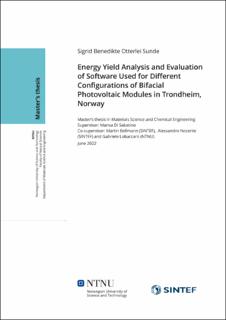| dc.contributor.advisor | Sabatino, Marisa (NTNU) | |
| dc.contributor.advisor | Lobaccaro, Gabriele (NTNU) | |
| dc.contributor.advisor | Bellmann, Martin (SINTEF) | |
| dc.contributor.advisor | Nocente, Alessandro (SINTEF) | |
| dc.contributor.author | Sunde, Sigrid Benedikte Otterlei | |
| dc.date.accessioned | 2022-10-15T17:19:26Z | |
| dc.date.available | 2022-10-15T17:19:26Z | |
| dc.date.issued | 2022 | |
| dc.identifier | no.ntnu:inspera:108213079:30343533 | |
| dc.identifier.uri | https://hdl.handle.net/11250/3026247 | |
| dc.description.abstract | Markedsandelen til tosidige solcellemoduler øker ettersom prisene på modulene konkurrerer med ensidige PV-moduler. Tosidige PV-moduler kan absorbere irradians fra både fram- og bakside, noe som resulterer i et høyere energiutbytte og energitetthet enn for ensidige paneler. Det er imidlertid lite forskning på temaet i det nordiske klimaet. Nordisk klima er preget av lange, milde dager om sommeren, og korte, kalde dager om vinteren. Spesielt mangler det litteratur på beste konfigurasjon for tosidige PV-paneler, og forskning på beste modeller å bruke for modellering av PV systemer for breddegrader langt nord.
I denne masteroppgaven undersøkes fire ulike konfigurasjoner av tosidige paneler plassert på campus Gløshaugen i Trondheim. Dette er et utendørs laboratorium installert på taket av Sentralbygg 1, kalt "Alfa Centuari" som eies og drives av SINTEF. Den første konfigurasjonen har en 44°tilt mot sør, deretter er det en vertikal vendt mot øst/vest, og en annen vertikal vendt mot sør/nord. Den siste er et to-akset trackingsystem, som følger solen gjennom dagen. Systemets målte verdier sammenlignes med simulert energiproduksjon fra PV*SOL og PVsyst. I tillegg utføres en analyse av de forskjellige dekomponeringsmodellene, som modellerer DHI, og transposisjonsmodeller, som modellerer irradians i modulens plan. Analysen er basert på
tilgengelige modeller i PV*SOL og PVsyst.
Basert på simuleringsresultatene fra denne oppgaven, viser 44°tilt mot sør den høyeste energiproduksjonen av de fastmonterte konfigurasjonene. Av de vertikale konfigurasjonene produserer sør/nord mer energi årlig enn øst/vest-konfigurasjonen. Imidlertid er forskjellen i produksjon liten og begge konfigurasjoner kan være fordelaktige avhengig av forbruker. For eksempel vil energiforbruket i en husholdning normalt være høyt om morgenen og ettermiddagen. Her vil en øst/vest-konfigurasjon vil være fordelaktig, siden denne konfigurasjonen produserer mer i disse tidsrommene. De beste kombinasjonene av dekomponering- og transposisjonsmodellene tilgjengelig i PV*SOL, er Erbs+Perez og Orgill + Hay for 44°tilt. Erbs + Perez viste
også gode resultater for den vertikale sør/nord- og trackingkonfigurasjonen, mens Reindl + Liu viste de beste resultatene for øst/vest-konfigurasjonen. I PV*syst er også Erbs + Perez den beste modellen for alle konfigurasjonene. | |
| dc.description.abstract | The total market share of bifacial photovoltaics (PV) panels is increasing as the prices of the modules are competitive with monofacial PV panels. Bifacial PV can receive irradiance from both the front and the rear sides, which results in higher energy yield and energy density than monofacial panels. However, there is little research on bifacial PV in the Nordic climate, which is characterised by long, mild days in the summer, and short, cold days in the winter. The literature on the best configuration for bifacial PV panels at high latitudes is ambiguous, and research on optimal sky models used for the modelling of PV systems in the Nordics is lacking.
In this master’s thesis, four different configurations of bifacial panels, located at campus Gløshaugen at NTNU in Trondheim, are investigated. This is an outdoor laboratory installed on the rooftop of Sentralbygg 1, called "Alfa Centauri", and is owned and operated by SINTEF. The first configuration has a 44° tilt towards the South, then there is one vertical panel facing East/West and another vertical facing South/North. The last is a two-axis tracking system that follows the Sun throughout the day. The measured values from this system are compared with simulated energy production from PV*SOL and PVsyst. In addition, an analysis of the different decomposition models, the modelling diffuse horizontal irradiance (DHI), the transposition models, and the modelling irradiance in the plane of the module, available in PV*SOL and PVsyst, is conducted.
Based on the simulation results, the 44° tilt towards the South shows the highest energy production of the fixed configurations. Of the vertical configurations, the South/North produces more energy annually than the East/West configuration. However, the difference in production is small and both configurations can be advantageous depending on the consumer. For example, in a household, energy consumption is high in the morning and the late afternoon; therefore, an East/West configuration would be beneficial since it produces more energy in these time slots than the South/North configuration. The best combinations of decomposition
and transposition models available in PV*SOL are Erbs + Perez and Orgill + Hay for the 44° tilt. Erbs + Perez also showed good results for the vertical South/North and the tracking configuration, while Reindl + Liu showed the best results for the East/West configuration. For PVsyst, Erbs + Perez was the best model for all configurations | |
| dc.language | eng | |
| dc.publisher | NTNU | |
| dc.title | Energy Yield Analysis and Evaluation of Software Used for Different Configurations of Bifacial Photovoltaic Modules in Trondheim, Norway | |
| dc.type | Master thesis | |
